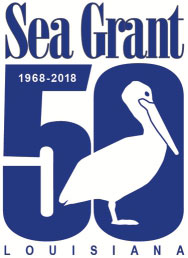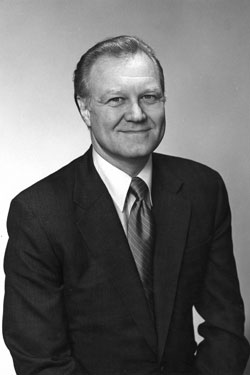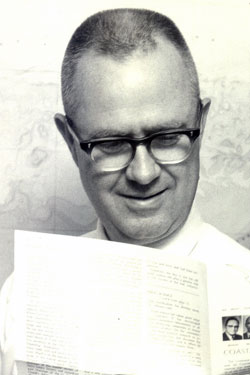Louisiana Sea Grant Marks a Half Century
 It was 86 degrees in Baton Rouge on July 1, 1968 – cooler than usual. The median monthly income of a family in the United states was $719. A woman’s haircut cost $2.15. Gasoline averaged 34 cents per gallon. And with initial funding of $198,000 from the federal government, Louisiana Sea Grant was born.
It was 86 degrees in Baton Rouge on July 1, 1968 – cooler than usual. The median monthly income of a family in the United states was $719. A woman’s haircut cost $2.15. Gasoline averaged 34 cents per gallon. And with initial funding of $198,000 from the federal government, Louisiana Sea Grant was born.
Two years earlier, Congress founded the National Sea Grant College Program which created a university-based system dedicated to the responsible development of the nation’s coastal and marine resources through research, education and extension. Officials at Louisiana State University recognized this unique opportunity and pursued establishing a state program under that federal umbrella.
“I was asked if I would like to come back to LSU and help set the thing up,” said Jack Van Lopik in a 2006 interview. “So, I came back from Texas Instruments … on a two-year leave of absence (from TI) just to get the program started.” Van Lopik, who earned his doctorate from LSU in 1955, ended up serving as Louisiana Sea Grant’s executive director for 37 years – 1968 to 2005. He passed away in 2015.
One of the first hurdles in launching Louisiana Sea Grant was money. State programs had to match federal funds with in-kind services or cash. “Lots of people (were) involved from the standpoint of trying to get matching funds,” said Van Lopik. “Hard cash matching … was one thing that would certainly impress the federal people. So, we did a lot of talking with legislators. This was done not only by myself, but by people like the chancellor and (other) people that were involved at LSU at the time.

Jack Van Lopik, circa 1970
“Key people were Sammy Nunez, who was a (state) senator at that time. Then there was Conway LeBleu and Ed Scogin on the House side. They really carried the ball as far as getting coastal people … to support the program.”
But even with support from LSU administration and state and federal funding, there was no guarantee university researchers would buy-into the Sea Grant concept. It’s multidisciplinary, applied research approach was not the norm.
“Sea Grant was across all different kinds of disciplines … not only from the science and engineering part of the university, but also from the law center and sociology and economics … trying an interdisciplinary approach to (solve) a lot of the problems in the coastal zone,” said Van Lopik. “Sea Grant was trying to get involvement of not just people in the academic community, but to get people from academia tied into real world problems, coastal zone management problems and things of that nature.
“You are trying to solve real world problems and trying to do things that are important at the local level…. If a business has a problem, they want it solved right away. They don’t want somebody to say, ‘Ok, we’ll write a proposal, do a three-year study of it, and then provide you with the information’,” Van Lopik added.
“Up to that time, LSU hadn’t done very much sponsored research. In fact, they didn’t even have a sponsored research administrator until probably 10 years after Sea Grant began,” said Ron Becker in a 2006 interview. Becker served as Louisiana Sea Grant’s associate executive director from 1970 to 2010. He also passed away in 2015.

Ron Becker, circa 1970
“Sponsored research really hadn’t caught on at LSU at that time, partly because the university didn’t push it,” Becker said. “A lot of the faculty at LSU that could have been doing research would go off and consult during the summer time, or work for NASA or do various things instead of getting research grants. But Sea Grant, as one of the early programs, gave a lot of researchers an opportunity to try it out and get into the field and really become creative and more aware of grant opportunities.
“I think I figured one time around 1970, or, well, sometime between ’70 or ’72, … (Louisiana Sea Grant) was a third of LSU’s total sponsored research,” Becker noted. “From about 1972 through 1979, we were the AgCenter’s major source of extramural funds for crawfish work.
“Virtually all of the marine programs in the School of Coast and the Environment … would have (not) come to pass if Sea Grant hadn’t been here to lead the charge. And of course, the Cooperative Extension Service … had no involvement whatsoever with the marine sector, with the people involved with fisheries and so on,” Becker said.
As a new faculty member at LSU in 1984, Chuck Wilson recognized Louisiana Sea Grant’s importance to his research and he received his first grant from the program the following year to study the reproductive biology of red drum. Twenty years later, Wilson took the helm as LSG’s second executive director – serving in that capacity for eight years, through 2012.
“That first year as Sea Grant director posed a number of challenges,” Wilson said. “It was 2005, and communities and businesses along the coast were devastated by Hurricanes Katrina and Rita.
“At that moment, the program took on more of a response and recovery role than it had ever had in the past. We developed models to assess the storms’ economic impacts on natural resources. We helped businesses in the commercial fisheries sector get back on their feet by brokering the acquisition of ice machines. We found lifts to get boats stranded onshore back in the water. And we funded architecture students to help communities explore more resilient ways to redevelop.
“When Hurricanes Gustav and Ike came along – as well as the 2010 oil spill – we were in a much stronger position to help coastal communities affected by those disasters. We also were able to share our experiences with other Sea Grant programs dealing with their own natural disasters and help walk them through the processes,” Wilson added.
During Wilson’s tenure, Louisiana Sea Grant laid the groundwork for a new oyster research lab on Grand Isle, began collecting oral histories and historic photos from commercial fishermen and coastal communities, and hired the program’s first female extension personnel. “It can’t be stressed enough that Sea Grant is about people – helping solve the problems our coastal population experiences. And Louisiana Sea Grant’s people are some of the best people at finding solutions,” Wilson said.
Robert Twilley became Louisiana Sea Grant’s third executive director in the summer of 2012. He has encouraged even greater multidisciplinary integration in research projects, the expansion of professional training for commercial fishermen and launched an initiative that expands young researchers’ knowledge of coastal concerns while honing their communication skills. As a young researcher, he also benefitted from Louisiana Sea Grant funding, initially in 1987.
“I can’t express how excited I am about Louisiana Sea Grant’s golden anniversary and how we continue the mission that originated five decades ago,” Twilley said. “Granted, many of the issues have changed in 50 years, but the research we fund today is no less important.
“For a program that celebrating a half-century of service, Louisiana Sea Grant continues to innovate and be a leader in bridging our state’s academic expertise with the needs of those who manage, conserve, enjoy and make their living on the coast. Louisiana Sea Grant has demonstrated that it is prepared to help coastal communities meet immediate and future challenges,” Twilley added.
“Louisiana’s coastal communities are experiencing accelerated environmental changes driven by the highest rates of coastal land loss and relative sea level rise, more than any other coastal region in the United States. In response, Sea Grant is creating more focus on strategic adaptations for communities and industry. An innovative research approach that is integrative across the sciences, just as described by our first director, Jack Van Lopik, is necessary to address our coastal issues. And we must continue to improve our ability to communicate that knowledge with strong engagement and outreach efforts.
“Louisiana Sea Grant will continue its leadership role in addressing these issues during our next 50 years,” Twilley added.
We would like to hear of your experiences with Louisiana Sea Grant. You can submit your comments to www.surveymonkey.com/r/BLR3CG2, as well as a photo of yourself. Comments and photos will be shared during a reception during the Fall of 2018 and also may be shared throughout the year online.
